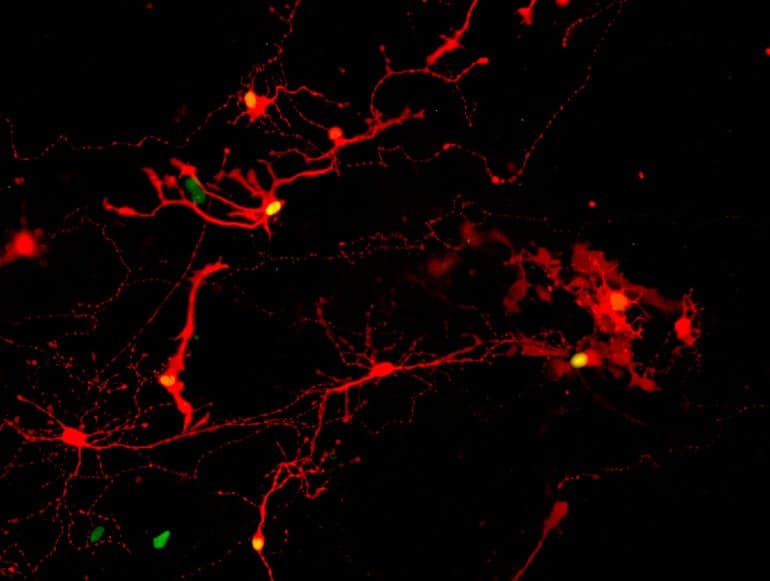
Summary: Retinal cells created in the lab from human stem cells can reach out and connect to neighboring cells, reports a new study. The cells have the ability to replace damaged retinal cells and carry sensory information. The findings could pave the way for clinical trials to treat a range of diseases associated with vision loss and blindness.
Source: University of Wisconsin
Retinal cells grown from stem cells can reach out and connect with neighbors, according to a new study, completing a “handshake” that could show the cells are ready for testing in humans with degenerative eye disorders.
More than a decade ago, researchers at the University of Wisconsin-Madison developed a way to grow organized clumps of cells, called organoids, that resemble the retina, the light-sensitive tissue at the back of the eye.
They coaxed human skin cells reprogrammed to act like stem cells to develop into layers of various types of cells in the retina that detect light and ultimately transmit what we see to the brain.
“We wanted to use the cells from these organoids as replacement parts for the same types of cells that were lost in the course of retinal disease,” says David Gamm, professor of ophthalmology at UW-Madison and director of the McPherson Eye Research Institute, whose lab developed the organoids.
“But after being grown in a laboratory dish for months as compact clumps, the question remained: will the cells behave properly after separating them? Because this is fundamental to introduce them into the patient’s eye.”
During 2022, collaborators at Gamm and UW-Madison published studies showing that dish-grown retinal cells called photoreceptors respond like those of a healthy retina to different wavelengths and intensities of light and that, once separated from adjacent cells in their organoid, they can reach out to new neighbors with characteristic biological cords called axons.
“The last piece of the puzzle was to see if these cords had the ability to connect or shake hands with other types of retinal cells to communicate,” says Gamm, whose new results on successful connections between cells will be published. this week at Annals of the National Academy of Sciences.
Retinal and brain cells communicate through synapses, tiny gaps at the ends of their cords. To confirm that their lab-grown retinal cells have the ability to replace diseased cells and carry sensory information like healthy ones, the researchers needed to show that they could make synapses.
Xinyu Zhao, a professor of neuroscience at UW-Madison and a co-author of the new study, worked with the cells in the Gamm lab to help study their ability to form synaptic connections. They did this by using a modified rabies virus to identify pairs of cells that could form the means of communicating with each other.
The research team, including graduate students and co-first authors Allison Ludwig and Steven Mayerl, separated the retinal organoids into individual cells, gave them a week to extend their axons and make new connections, exposed them to the virus. and then took a peek. What they saw were many retinal cells stained with a fluorescent color, indicating that a rabies infection had infected someone through a successfully formed synapse between neighbors.
“We’re building this story together in the lab, one piece at a time, to build confidence that we’re moving in the right direction,” says Gamm, who patented the organoids and cofounded Madison-based Opsis Therapeutics, which is adapting the technology. to treat human eye disorders based on UW-Madison findings.

“It’s all ultimately leading to human clinical trials, which is the clear next step.”
After confirming the presence of synaptic connections, the researchers analyzed the cells involved and found that the most common types of retinal cells forming synapses were photoreceptors – rods and cones – which are lost in diseases such as retinitis pigmentosa and age-related macular degeneration, as well as certain eye injuries. The next most common cell type, retinal ganglion cells, degenerate in optic nerve disorders such as glaucoma.
“That was an important revelation for us,” says Gamm. “This really shows the potentially broad impact these retinal organoids can have.”
About this research news in genetics and visual neuroscience
Author: Chris Barncard
Source: University of Wisconsin
Contact: Chris BarncardUniversity of Wisconsin
Image: The image is credited to UW-Madison / Gamm Laboratory.
Original search: Free access.
“Reformation of synaptic connectivity in cultures of retinal organoids derived from dissociated human stem cells” by Allison L. Ludwig et al. PNAS
See too

Summary
Reformation of synaptic connectivity in cultures of retinal organoids derived from dissociated human stem cells
Retinal organoids (ROs) derived from human pluripotent stem cells (hPSC) can efficiently and reproducibly generate retinal neurons that have potential for use in cell replacement strategies [Capowski et al., Development 146, dev171686 (2019)].
The ability of these lab-grown retinal neurons to form new synaptic connections after ROs dissociate is critical to increasing confidence in their ability to restore visual function.
However, direct evidence of reestablishment of retinal neuron connectivity via synaptic tracing has not been reported to date.
The present study employs an in vitro rabies virus-based monosynaptic retrograde tracking assay. [Wickersham et al., Neuron 53, 639–647 (2007); Sun et al., Mol. Neurodegener. 14, 8 (2019)] to identify de novo synaptic connections between early retinal cell types after RO dissociation. A reproducible, high-throughput approach to labeling and quantifying screened retinal cell types has been developed.
Photoreceptors and retinal ganglion cells – the primary neurons of interest for retinal cell replacement – were the two main contributing populations among the presynaptic cells screened. This system provides a platform to assess synaptic connections in cultured retinal neurons and sets the stage for future cell replacement studies aimed at characterizing or enhancing synaptogenesis.
Used in this way, in vitro synaptic tracking is designed to complement traditional preclinical animal model testing, which is limited by evolutionary incompatibilities in the synaptic machinery inherent in human xenografts.


0 Comments